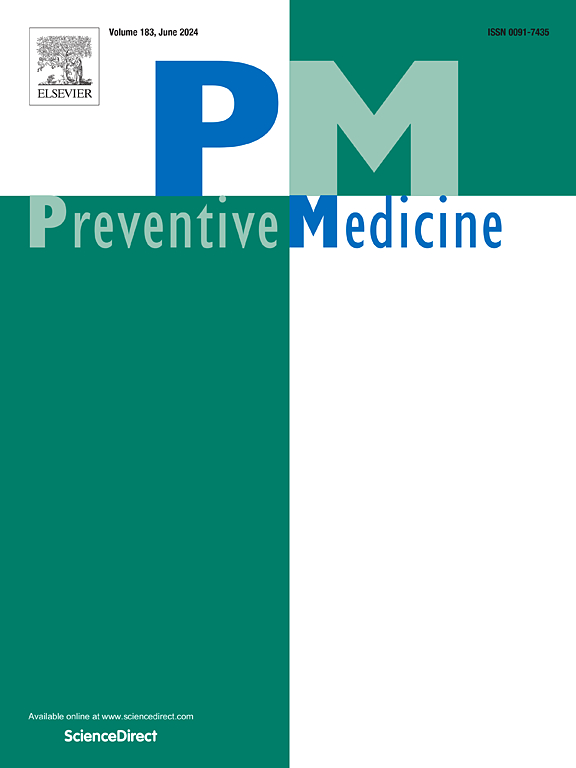持续极低收入和收入减少与帕金森病风险的关系:韩国一项基于人群的全国队列研究
IF 3.2
2区 医学
Q1 MEDICINE, GENERAL & INTERNAL
引用次数: 0
摘要
目的以往关于收入与帕金森病关系的研究只评估了一个时间点的收入状况,而没有考虑随时间的变化。本研究旨在评估不同收入动态与帕金森病风险之间的纵向关联。方法:我们使用韩国国民健康保险服务的数据,纳入了参加2012年国家健康筛查计划的2,644,550人。国家健康保险费被用作收入的替代衡量标准,分为四个等级(四分位数1[低]至4[高])。此外,医疗援助被列为极低收入。使用ICD-10代码(G20)和罕见难治性疾病登记代码(V124)对帕金森病进行定义。采用Cox比例风险模型评估收入状况与帕金森病发病率之间的纵向关联。结果在研究期间,帕金森病的发病率为27.13 / 10万人/年。发现极低收入状态的累积年数与帕金森病发病率之间存在剂量反应相关性(P代表趋势<;0.001)。从2008年到2012年,收入从四分位数1 (HR = 2.19, 95% CI 1.55, 3.09)、四分位数2 (HR = 2.56, 95% CI 1.75, 3.74)或四分位数3 (HR = 2.20, 95% CI 1.24, 3.88)下降到极低收入者,与持续收入状况的个体相比,帕金森病发病率增加了两倍以上。结论连续5年以上持续收入极低的个体和收入下降到这一水平的个体患帕金森病的几率明显较高。本文章由计算机程序翻译,如有差异,请以英文原文为准。
Association of sustained extremely low income and income decrease with the risk of Parkinson's disease: A population-based nationwide cohort study in Korea
Objective
Previous studies on the association between income and Parkinson's disease assessed income status at a single time point, without considering changes over time. This study aimed to evaluate the longitudinal association between various income dynamics and the risk of Parkinson's disease.
Methods
We used the Korean National Health Insurance Service data, enrolling 2,644,550 individuals who participated in the 2012 National Health Screening Program. The national health insurance premium was used as a proxy measure of income, with four levels (quartile 1 [low] to 4 [high]). Additionally, Medical Aid was classified as extremely low-income. Parkinson's disease was defined using the ICD-10 code (G20) and the rare intractable disease registration code (V124). Cox proportional hazards models were used to assess the longitudinal association between income status and Parkinson's disease rate.
Results
During the study period, the incidence rate of Parkinson's disease was 27.13 per 100,000 person-years. A dose-response association between the cumulative number of years in the extremely low-income status and Parkinson's disease rate was identified (P for trend <0.001). A decrease in income from 2008 to 2012 to extremely low-income from quartile 1 (HR = 2.19, 95 % CI 1.55, 3.09), quartile 2 (HR = 2.56, 95 % CI 1.75, 3.74), or quartile 3 (HR = 2.20, 95 % CI 1.24, 3.88) was associated with more than a two-fold increased Parkinson's disease rate compared to individuals with sustained income status.
Conclusions
Individuals with sustained extremely low income over 5 consecutive years and those who experienced a decrease in income to this status were at a significantly higher rate of developing Parkinson's disease.
求助全文
通过发布文献求助,成功后即可免费获取论文全文。
去求助
来源期刊

Preventive medicine
医学-公共卫生、环境卫生与职业卫生
CiteScore
7.70
自引率
3.90%
发文量
0
审稿时长
42 days
期刊介绍:
Founded in 1972 by Ernst Wynder, Preventive Medicine is an international scholarly journal that provides prompt publication of original articles on the science and practice of disease prevention, health promotion, and public health policymaking. Preventive Medicine aims to reward innovation. It will favor insightful observational studies, thoughtful explorations of health data, unsuspected new angles for existing hypotheses, robust randomized controlled trials, and impartial systematic reviews. Preventive Medicine''s ultimate goal is to publish research that will have an impact on the work of practitioners of disease prevention and health promotion, as well as of related disciplines.
 求助内容:
求助内容: 应助结果提醒方式:
应助结果提醒方式:


